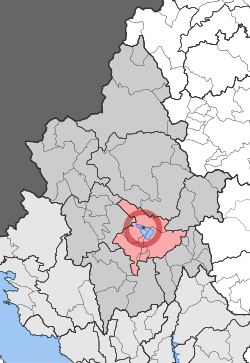Ioannina island
|
Municipality of Ioannina Island (Nisi Ioanninon) Δημοτική Ενότητα Νήσου Ιωαννίνων (Νησί Ιωαννίνων) |
||
|---|---|---|
|
|
||
| Basic data | ||
| State : |
|
|
| Region : |
Epirus
|
|
| Regional District : | Ioannina | |
| Municipality : | Ioannina | |
| Geographic coordinates : | 39 ° 41 ′ N , 20 ° 53 ′ E | |
| Height above d. M .: | 470 - 522 m lake level - highest point |
|
| Area : | 0.432 km² | |
| Residents : | 219 (2011) | |
| Population density : | 506.9 inhabitants / km² | |
| Code No .: | 180104 | |
| Structure: |
1 municipality |
|
| Located in the municipality of Ioannina and in the regional unit of Ioannina | ||
The Ioannina Island ( Greek Νησί Ιωαννίνων Nisí Ioannínon ( n. Sg. ), Regionally also Νησάκι Nisaki 'islet' for short ; Albanian Ishulli e Janinës ) is a small inland island in the north of Lake Ioannina or Pamvotida in the Greek region of Epirus . From 1926 until it was re-incorporated into the city of Ioannina , it was an independent rural community (κοινότητα kinótita ) in the prefecture of Ioannina and the smallest Greek municipality in terms of area. Today it is a municipality in the municipality of Ioannina and, as a former municipality, is also a municipality.
The limestone island is elongated in shape, about 1000 m long and 500 m wide. The interior of the island rises to about 50 m above the surface of the lake and is covered by forest, pine and cypress trees characterize the landscape. The settlement is at the northern end of the island. Reeds and papyrus line the banks, which are home to frogs and toads and where numerous water birds breed. The lake, which still freezes over occasionally in winter, is home to numerous freshwater fish such as carp , eels and sturgeon as well as freshwater crabs .
Although the area of the around 10,000 year old Pamvotida Lake has demonstrably been inhabited since the third millennium BC, the oldest evidence for people on the island consists of preserved monastery buildings, the oldest of which date from the 13th century, the time of the beginning despotate of Epirus . There are a total of seven monasteries on the island today, at least four of which date from the late Middle Ages, and a church school since 1871. The residents consider themselves the descendants of refugees from the Mani peninsula in the 17th century, which research has not yet proven. Toponyms of Slavic origin in the area around the lake and on the island suggest a settlement by Slavs from around the 10th century.
The island came into the light of history when Ali Pasha Tepelena fled there from his Ottoman opponents in February 1822 and was defeated and killed in a cell of the Pandeleimon monastery.
The around one hundred families on the island traditionally live from fishing and frog breeding , and the island is also of great tourist importance as a destination for excursions . Handicraft items such as straw hats are offered as souvenirs . The culinary specialties of the place include various fish and crab dishes as well as frog legs.
Attractions
Main attractions are the church and the seven monasteries in which significant traces of Byzantine frescoes art are, including the Church of the Assumption (Ιερός Ναός Κοίμησης της Θεοτόκου) with a wooden iconostasis with gilded icons, the rock monastery of St. John the Baptist (Μονή Αγίου Ιωάννη Προδρόμου ) from the 14th century and the monastery of St. Pandeleimon (Μονή Αγίου Παντελεήμονος) from the 15th century. In this monastery, the 'Museum of the Time Before the Uprising' (Μουσείο Προεπαναστατικής περιόδο) commemorates Ali Pasha. The cell in which he found death is shown here, as well as lithographs, copperplate engravings and textiles from before 1822.
The monastery of St. Nicholas the Philanthropine (Μονή του Αγίου Νικολάου των Φιλανθρωπινών) is considered to be the most significant in terms of art history . The name comes from a family Philanthropinos , an important family in the despotate Epirus, whose member Michael is mentioned in 1292 as the owner of the monastery. The building contains important wall paintings from the 13th and 14th centuries. In the southern narthex are the portraits of seven ancient philosophers.
Close to this monastery on the northeast side of the island is the monastery of St. Nicholas Dilios (Stratigopoulos) , founded probably in the 13th century. The main church is completely painted with frescoes from 1542/3.
Web links
- Portraits of the monasteries and history on the website of an elementary school in Ioannina (Greek)
- Portrait of the lake and island ( memento of October 26, 2007 in the Internet Archive ) on epirus.de
Individual evidence
- ↑ Results of the 2011 census. ( Memento from June 27, 2015 in the Internet Archive ) ( MS Excel ; 2.6 MB) National Statistical Service of Greece (ΕΛ.ΣΤΑΤ)
- ^ Barbara N. Papadopoulou: The Monasteries of the Island of Ioannina. The Holy Elousa Monastery . Ioannina 2004, ISBN 960-86636-9-5 .




